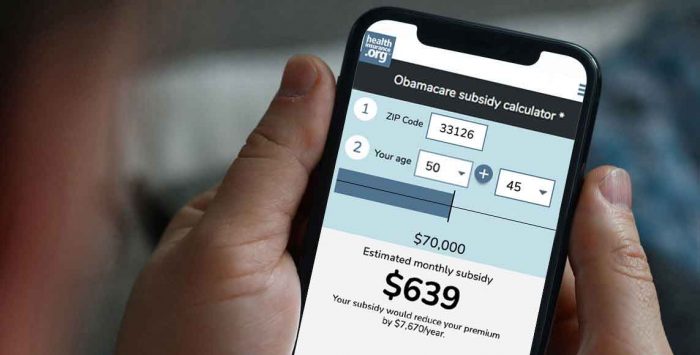Please provide your zip code to see plans in your area.
Featured

Featured

premium tax credit
What is a premium tax credit?
What is a premium tax credit?
A premium tax credit – often referred to as a premium subsidy – is a tax credit that offsets some or all of the amount that policyholders would otherwise have to pay to purchase individual or family health insurance. Premium tax credits are one of many Affordable Care Act provisions designed to make individual market health insurance coverage affordable.
As a result of the American Rescue Plan, premium subsidies are larger and more widely available in 2021 and 2022 than they normally are.
Premium subsidies are only available to use with health insurance purchased through the marketplace in your state. (In other words, you forfeit the premium tax credit if you shop off-exchange, even if you’d otherwise be eligible to claim it).
When do I receive the premium tax credit?
Unlike other tax credits, the premium tax credit can be (and usually is) provided upfront, throughout the year. The IRS sends it to your health insurer each month, so that you don’t have to pay as much yourself. The premium tax credit is then reconciled on the policyholder’s tax return the following spring.
Alternatively, policyholders can choose to pay full price for a health plan in their state’s exchange, and then claim the entire premium tax credit on their tax return. However, few people do that, as the cost of coverage without the advance premium tax credit is generally out of reach for those who do end up qualifying for the premium tax credit.
What is an advance premium tax credit?
An advance premium tax credit, or APTC, is the name for a premium tax credit when it is paid in advance each month to an enrollee’s insurance carrier. The alternative is to pay full-price for health insurance through the exchange/marketplace and then claim the premium tax credit from the IRS when you file your taxes.
What factors affect an enrollee’s premium tax credit (PTC)?
Premium tax credit eligibility depends on income (an ACA-specific calculation of modified adjusted gross income). Although the rules are different in 2021 and 2022, it’s normally available to people with income between 100% and 400% of the federal poverty level, although the lower bound in most states is actually 138% of the federal poverty level, due to Medicaid expansion (if you’re eligible for Medicaid, you won’t be eligible for a premium tax credit).
For 2021 and 2022, the income cap (400% of the poverty level) for premium tax credit eligibility does not apply. So depending on the cost of the benchmark plan relative to a household’s income, some people can qualify for a premium tax credit in 2021 and 2022 even with an income well above 400% of the poverty level. This is due to the American Rescue Plan (ARP), which was enacted in March 2021 to address the ongoing COVID pandemic.
Under the ARP, premium tax credit eligibility for people over 400% of the poverty level is based on keeping the cost of the benchmark plan at no more than 8.5% of household income, and this was retroactive to January 2021. So for 2021 and 2022, there is no income limit for subsidy eligibility — instead, it depends on what percentage of your income you’d otherwise have to pay for the benchmark plan.
The cost difference between the benchmark plan and an enrollee’s selected plan determines their monthly premium. In 2022, the full-price premiums for plans purchased via HealthCare.gov (used by 33 states) averaged $594 a month, but 92% of enrollees received advance premium tax credits that averaged $524 per month. For those enrollees, the average tax credit covered the majority of the average premium, although the specifics vary considerably from one person to another and from one area to another.
Because premium tax credits are usually paid in advance, they are reconciled against your actual income when the year is over. This means enrollees who underestimate their income may have to pay back a large portion of their subsidy – or all of it – when filing their taxes.
Will being offered employer-sponsored coverage make me ineligible for tax subsidies?
You won’t qualify for premium subsidies if you’re eligible – including as a spouse or dependent – for an employer-sponsored plan that meets comprehensiveness and affordability requirements.
In 2022, an employer-sponsored plan is considered affordable if it costs less than 9.61% of household income for employee-only coverage. An affordable employer-sponsored plan will disqualify a taxpayer from receiving a tax subsidy if it also provides minimum value (i.e., it covers at least 60% of an average enrollee’s costs and provides “substantial coverage” for inpatient and outpatient services).
But this affordability test only applies to the employee’s coverage costs. As long as those costs are considered affordable and the plan offers minimum value, spouses and dependents are not eligible for premium subsidies. This situation is called the family glitch. However, the Biden administration is working on a fix for the family glitch that’s expected to be in place by 2023. This will make some employees’ family members newly eligible for premium tax credits in the marketplace.
Can I receive a tax subsidy if I’m eligible for Medicaid because of ACA’s Medicaid expansion?
Eligibility for premium tax credits begins at 100% of the federal poverty level in states that did not implement ACA’s Medicaid expansion. However, the ACA allowed states to expand Medicaid to adults under 65 with incomes up to 138% of the poverty level.
As discussed earlier, taxpayers aren’t eligible for premium tax credits if they’re eligible for Medicaid or CHIP. In the 38 states that have adopted the Medicaid expansion, premium subsidies are available beginning above 138% of the poverty level (in Washington DC, Medicaid eligibility extends much higher, to 215% of the poverty level; premium tax credit eligibility starts above that).
Eligibility limits for CHIP are much higher than for Medicaid – and can be above 300% of the poverty line in some states. This means that in many households, adults qualify for premium subsidies and children qualify for CHIP.
How is my eligibility impacted if my state didn’t expand Medicaid?
Your household income must equal at least 100% of the poverty level in order to qualify for a premium subsidy. Americans who live in states that didn’t expand Medicaid can fall into a Medicaid coverage gap – where they earn too much to qualify for Medicaid, but not enough to qualify for premium tax credits.
However, there is no coverage gap for recent immigrants who are legally present in the U.S., as the ACA allows recent immigrants to access premium subsidies even if their income is below the poverty level. This is because they aren’t eligible for Medicaid until they’ve been in the U.S. for five years, and Congress didn’t want them to fall into a coverage gap, so these provisions were written into the ACA (but lawmakers had no way of knowing that the Supreme Court would make Medicaid expansion optional, which is why the Medicaid expansion coverage gap exists).
How did the elimination of federal funding for cost-sharing reductions affect premium tax credits?
In late 2017, the federal government stopped reimbursing insurers for providing cost-sharing reductions (CSRs) – which lower co-pays, deductibles, and other out-of-pocket expenses in silver plans. (American Indians and Alaskan Natives receive CSRs in any marketplace plan.)
Silver plan enrollees with incomes below 250% of the poverty line are legally entitled to CSRs regardless of whether the government reimburses insurers for providing them. As a result, insurers in most states began incorporating the costs of providing CSRs into all silver plans. This practice is called “Silver loading,” and it increases the premium subsidies available to all enrollees.
Indiana and Mississippi still require insurers to incorporate costs from CSRs using a different method – called “broad loading” – which does not significantly increase premium subsidies for enrollees in those states.
Related articles
Legislation signed today provides substantial premium tax credits and cost-sharing reductions to Americans receiving unemployment benefits.
How the Affordable Care Act's subsidies are calculated, and who is eligible to receive them under the American Rescue Plan.
Most exchange enrollees are eligible for premium subsidies, and the American Rescue Plan makes these subsidies larger and more widely available through 2022.
Sweeping health reform legislation delivered a long list of provisions focused on health insurance affordability, consumer protections.









